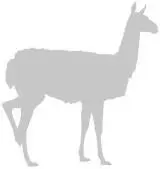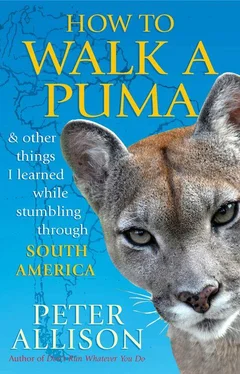I pushed ahead again, my palms forward, my legs moving in a blind zombie shuffle. After a while, my hands brushed something soft and furry. I flinched back, stumbling again, and bounced off a tree. Suddenly I felt claws clutching me from all sides, and flailed, terrified. Something was biting me, tearing at me.
Despite my fear, I forced myself to stay still and think rationally. The furry thing I’d felt was most likely balsa fluff—drifting cotton from a kapok tree—though in my head I was sure it was a big ugly tarantula, hairy and mobile, like a Russian’s knuckles going for a walk. Luckily the claws turned out to be nothing more than thorny vines, which I picked my way out of. Incapable of stopping now, I blundered on, the generator noise definitely louder, the path definitely gone.
‘Go to the light!’ friends of faith have implored me over the years. And I finally did. Ahead of me a light pulsed; at first I thought it was just another firefly flaunting its freedom, but it came again, not blinking, just strobing in and out of my vision as the angle between it and the foliage changed. I made a beeline towards it, stumbling forward, finally tripping on a raised walkway, then sprawling once more, my hands in front of me balled into fists in case of spiders.
Next thing I knew I smashed into hard timber, falling down. I got up, too thrilled to feel much pain, felt my way to the entrance, and shuffled into the lodge feeling jubilant. I had no idea what time it was, and just hoped a search party hadn’t formed.
I short-cutted through the back of the lodge and dashed into my room without passing any staff. It was 7.45 pm. I had been lost for less than two hours, and was only a few minutes late for dinner.
During the meal there was an announcement that Dan would be leading a night walk; thinking it would probably be good to get straight back on the tarantula, so to speak, I arrived before anyone else at the designated meeting place for the walk. A halogen lamp illuminated the spot, and bugs of hallucinogenic diversity dipped and dived at it, some bouncing off, stunned, into the grass below. When a lurid green cicada with bright red eyes did just this, I reached down to grab it and take a closer look. The shadow my arm cast swelled and lengthened, as if a giant were probing the earth, and the shadow of a twig made a dark stripe on the lawn close beside it.
‘That twig looks a bit like a snake,’ I thought. Just then the ‘twig’ flicked a forked tongue at my arm. I retracted the limb with such speed it may have made a sonic pop, and Dan arrived soon after to find me sprawled on the deck trying to get a closer look at what he quickly identified as a cat-eyed snake.
‘Mostly harmless,’ he said. ‘Lucky it wasn’t a fer-de-lance,’ he added, naming one of the region’s most venomous and aggressive snakes. If it had been a fer-de-lance (or a viper or bushmaster, two of South America’s other venomous snakes), I would have been at serious risk of losing a limb, if not my life.
No matter how well I had hidden from the howlers, clearly I was not in possession of proper jungle skills. There and then I decided that not only was I ill-suited for a return to guiding, but that perhaps the jungle as a whole was not a great place for me to spend much more time. After Sacha, I was going to London to visit Lisa, and after a short stay there planned on coming straight back to South America. Perhaps the sensible thing would be to stay in the UK and give up my wanderings. Maybe I’d been right after all when I left the bush and went back to Australia.
‘Nah,’ I thought. ‘Time to go deeper.’ And with that idea began my most extreme journey so far.
Meeting the People

‘Man, what happened to your face?’ Tom asked me in his usual jovial tone, his Southern accent pronounced even though he’d lived in Ecuador for more than twenty years. Beside him stood a man I knew must be Otobo. Little more than five foot tall but powerfully built, he greeted me warmly. We were in Coca, a small town close to Sacha; from here I would head further into the Amazon basin, where I would visit Otobo’s tribe, the Huaorani.
‘Muggers,’ I explained to Tom, a friend of friends. ‘Three of them. And I’d had enough to drink to think it was a good idea to fight back. Probably wasn’t,’ I finished, indicating my black eye and swollen lip, still prominent two days after the event.
Tom translated this into Spanish for Otobo, no doubt being more than a little generous about my prowess. Otobo nodded at me, apparently impressed at my warrior spirit. Perhaps my misshapen nose (a product of genetics, not fighting) gave the impression that I fought a lot. And lost often.
‘All three ran from me,’ I carried on, encouraged, but then some fondness for honesty made me add, ‘Admittedly by then they had twenty dollars and a credit card.’ Tom again translated, but even with my limited Spanish I could tell he was once again speaking up my fighting abilities. It hadn’t been much of a brawl—my style was less martial arts and more crazed raccoon—but it had reminded me that not everyone I met on this trip would be friendly.
That we were standing in the somewhat modern streets of Coca having this meeting at all was quite remarkable, as the Huaorani only became aware of the outside world—and the world of them—in the late 1950s. The tribe’s name means ‘the people’, as they consider outsiders of any ethnic group to be something else, usually cowode , a term that can be roughly translated as ‘cannibal’. Since their introduction to the outside world they have been the targets of missionaries and ruthless oil companies, the two groups sometimes working in cahoots to drive them from their land.
Otobo had met Tom and his wife Mariela when they helped a neighbouring tribe, the Kichwa, set up an ecotourism operation. Even though some of his family had dabbled in working for the oil companies and others had strayed to cities, Otobo saw that perhaps the only way to preserve his culture would be to start his own tourist operation, and let outsiders see how and where the Huaorani live. I was to spend three weeks with him, three weeks of no telephones, internet, newspapers or modern distractions of any kind. With the Minke in London and no way to communicate with her I kept a diary for the first time in twenty years; as it turned out, my time with the Huaorani would be some of the most extraordinary weeks of my life.
•
Three English tourists met Tom, Otobo and myself and we set off from Coca on an open-backed truck with bench seats, driving along the Via Auca (literally ‘Road of Savages’, a name given by the oil companies who had the road built, and a label the Huaorani are none too keen on). Until its construction, most Huaorani had lived deep in the rainforest, usually far from major waterways, relying on the forest, not water, for their livelihood. These habits had allowed them to stay undetected for so long, but as more roads were proposed their isolation was under threat.
Along the way several other Huaorani people that Otobo knew flagged us down and jumped on board. After several hours on a road well cared for by the oil companies we came to a checkpoint that marked the entry to Yasuni National Park, where military officials checked our health papers and stamped us in, as if we were leaving Ecuador and entering a whole new country. In the minds of the Huaorani, of course, we were. This was their land.
After the checkpoint we transferred to motorised canoe, travelling for several more long hours down the Cononaco River. Otobo was very proud of his vessel, a long river craft made of fibreglass; its modern appearance became increasingly out of place the further we went into the park, seeing fewer and fewer signs of development, then no sign of humanity at all.
Читать дальше













